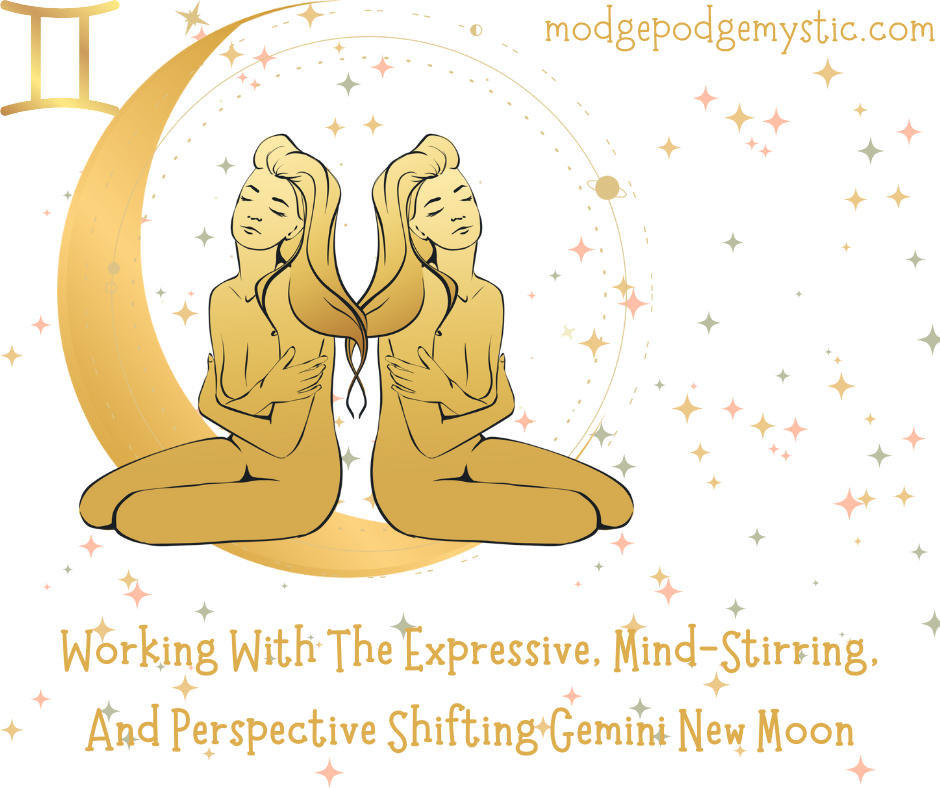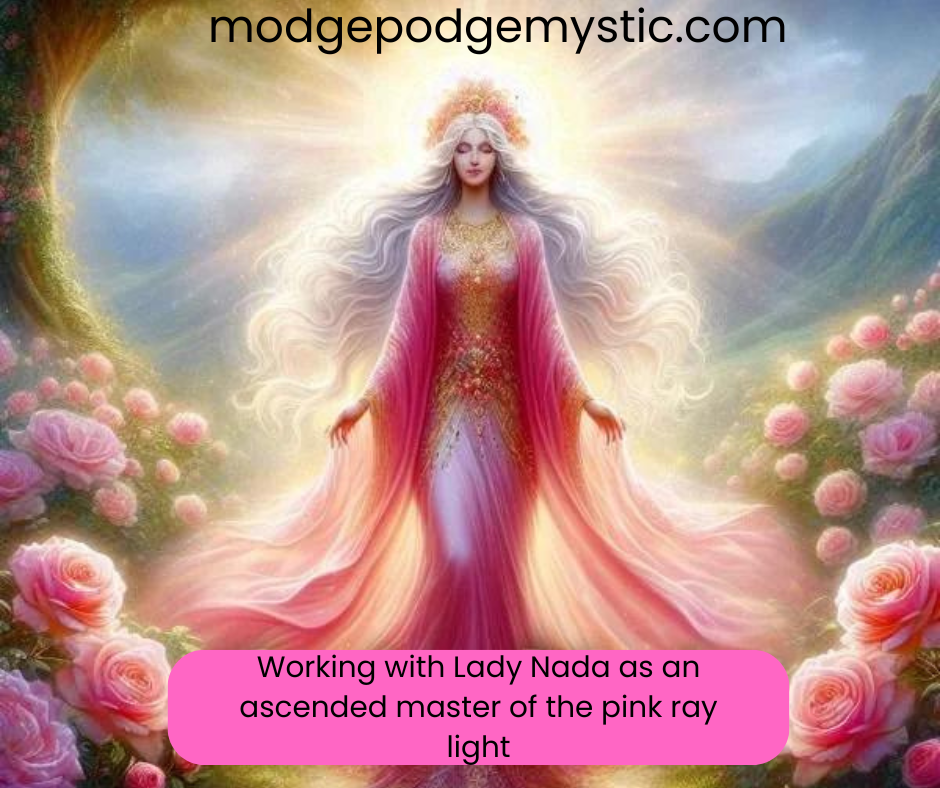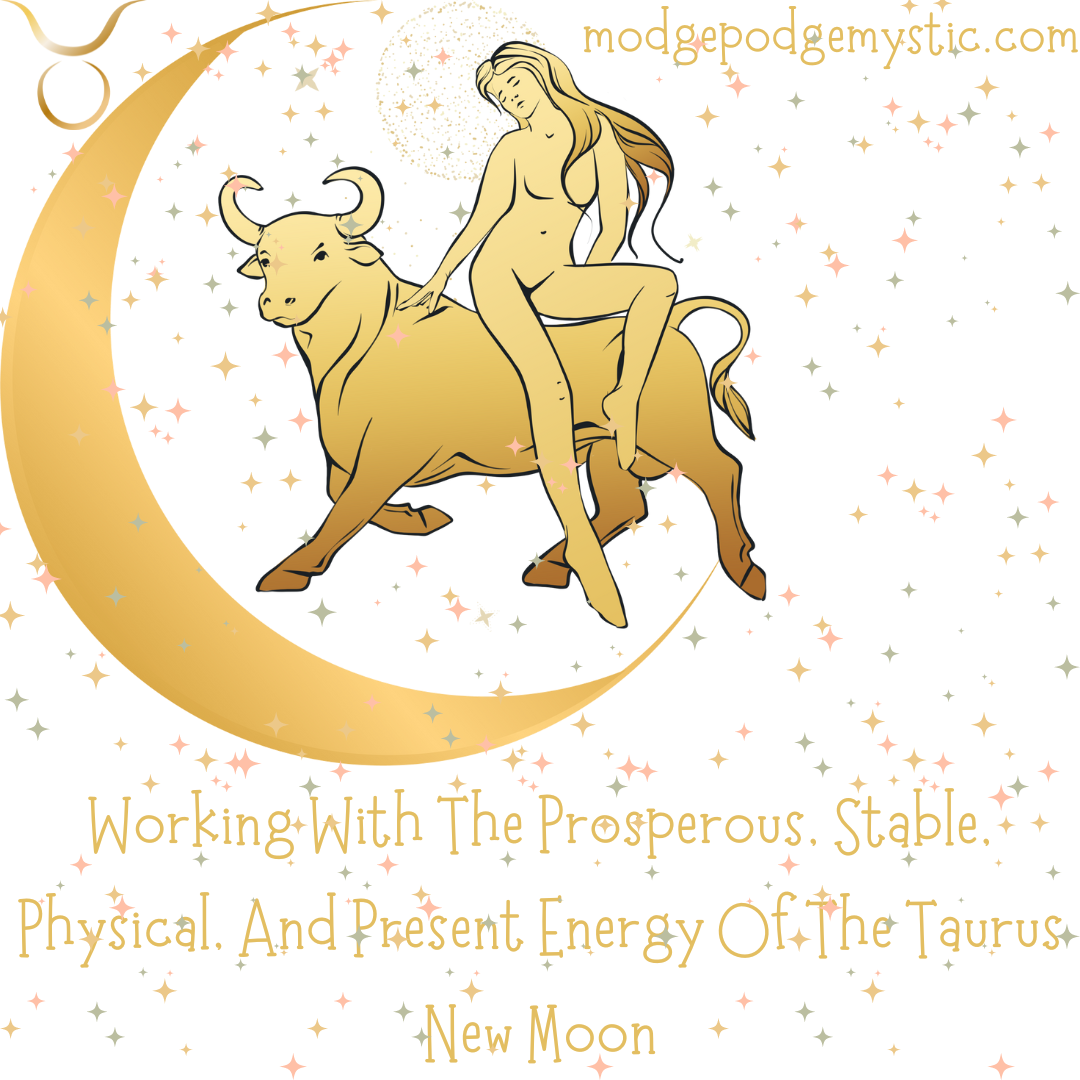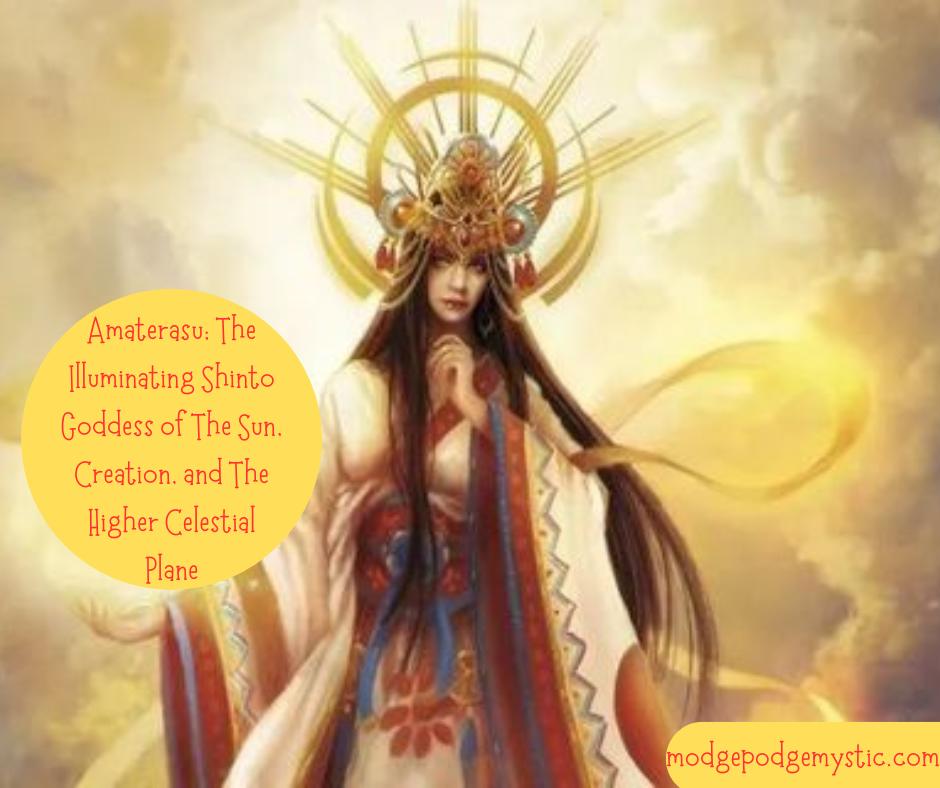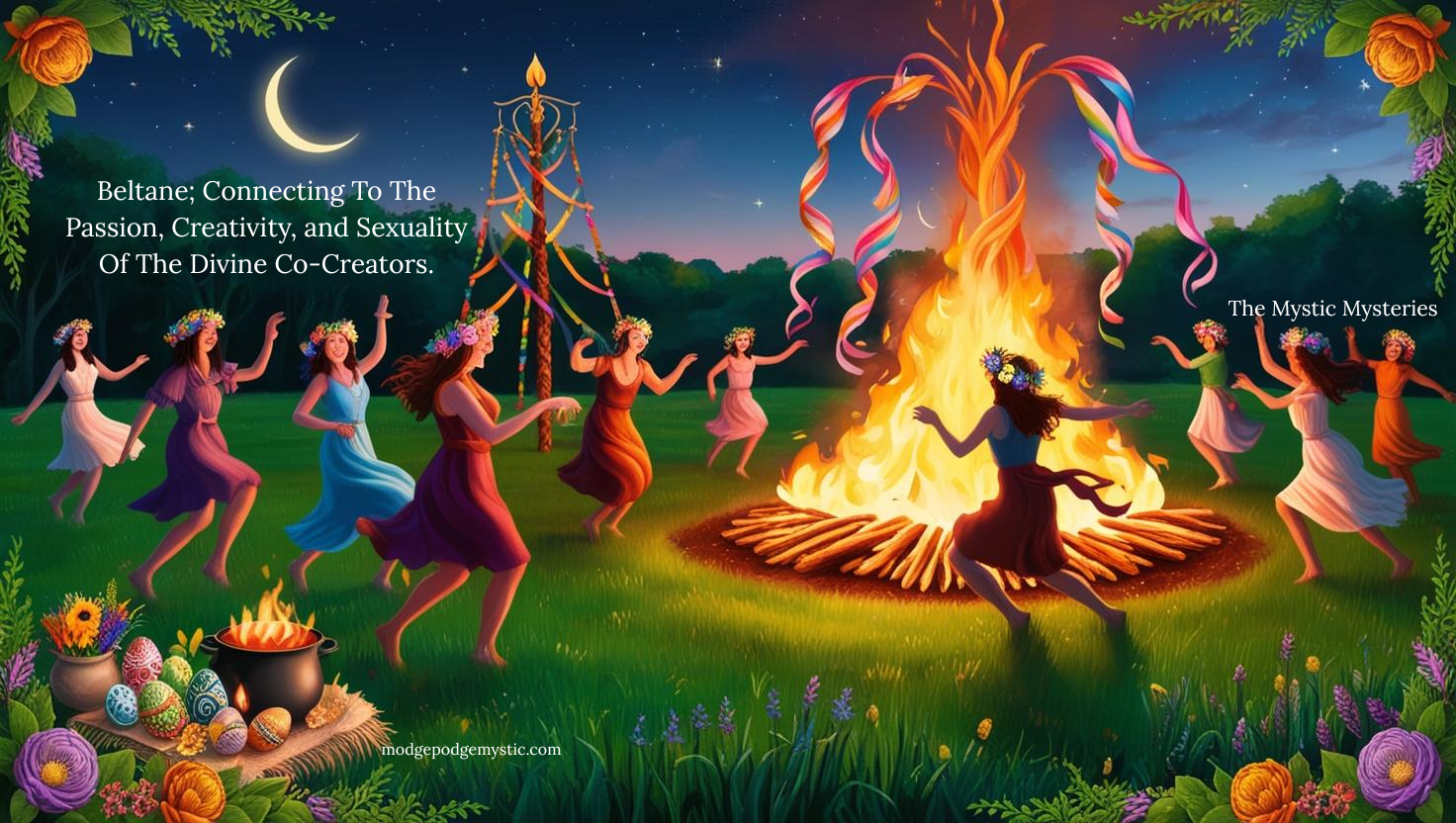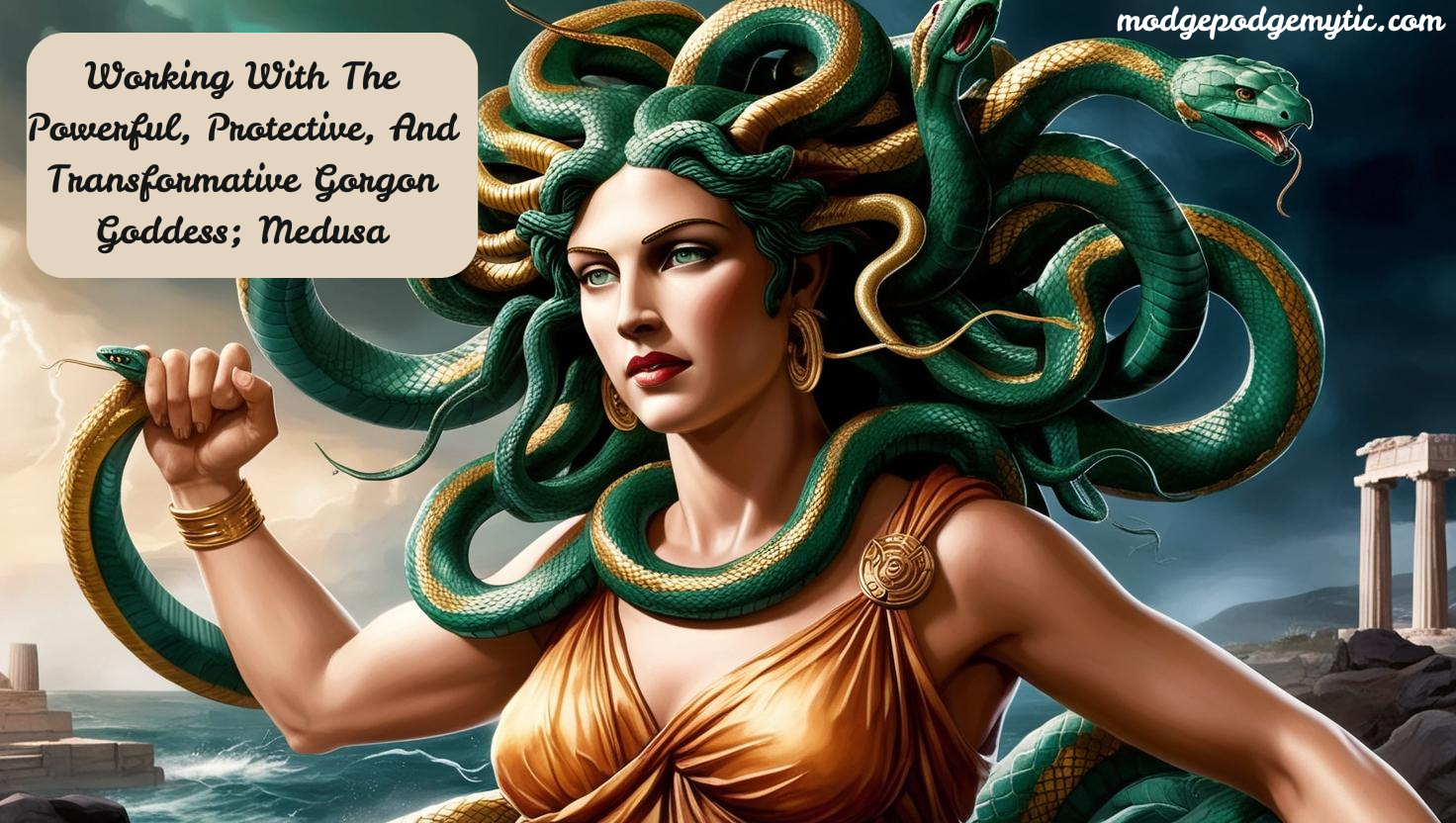

The legend of Medusa is well-known in Greek mythology. It tells of a beautiful woman transformed into a gorgon: who some would consider to be a hideous monster with venomous serpents for hair. She is feared by many, especially men. This is because, she is incredibly misunderstood. Due to the fact that most of her myth and story isn’t commonly told and her tragic beginning many have tried to have lost in the waters of time. The truth behind the myth of Medusa doesn’t start with Perseus. It doesn’t even start with Medusa being cursed by Athena. It starts long before that, with the god of the sea Poseidon.
Because of her story many pagans and witches, especially women chose to work with her as a goddess. She’s a powerful symbol of transformation. Transformation of anger and pain into passion and drive, accountability for oneself and growing from it. Seeing ourselves for who we truly are at our core, and approaching your obstacles and challenges with ferocity. Her name says it all; “Medusa” means “guardian, or protectress”. As a Gorgon, Medusa also represents a primordial force of chaos and destruction, embodying the untamed and unpredictable aspects of the natural world. Her petrifying gaze can be interpreted as a reminder of the inherent danger and potential for devastation that exists within the natural order. She uses it to protect others, especially women. And to show others their true nature; if they choose to take from another something they have no right to take.
Let go of your fear about her and come with me to stare into the slithering snakes upon her head to learn the truth about her myth, how she is much more than a monster but, a goddess who was demonized, and how to work with her.
Who Is Medusa?
Most view Medusa as a monster and they would be partially correct, but she is a goddess as well born of divine blood. Medusa is a complex being whose name evokes different emotions: fear, awe, anger, fascination and even courage. Her name means “guardian” or “protectress”. Medusa was born to two sea deities Ceto and Phorcyos, along with her sisters, Euryale (The far springer) and Stheno ( the mighty or strong). For some reason I can’t quite figure out why, but Medusa was mortal unlike her sisters. Medusa was shockingly beautiful as a mortal. She had long, silky hair and a beautiful body. She was a devotee of the Goddess Athena. Medusa was loyal to Athena and vowed to follow her path.
Medusa The Guardian and Protector
Medusa is a very powerful goddess to work with for protection. I mean her name says it all; “Medusa” means “guardian, or protectress”. Medusa literally means the definition of power and being the powerful one. Not only that but, she was devoted to Athena and had learned many forms of protection while guarding her temple. Which allows her to lend her guardianship to those who seek it when they call to her. Don’t forget her origin either which adds even more power behind her protection. Born of the sea gods Phorcys and Ceto, it is often forgotten that Medusa herself is a goddess of the sea. Which is a place of immense power and has the capability to do serious damage to the earth and humans if it chooses to. Her rage which she calls on for protection, is as powerful as the most ravenous hurricane and has the ability to drown those who seek to harm her.
Medusa The Demonized Victim
Medusa’s story is the tale of the deep cut of society’s knife: creating, blaming, and demonizing the victim for being in the wrong place at the wrong time. Medusa’s tale is unfortunately a common one in myths and legends especially for the Greek pantheon. It’s a tale of a beautiful women being defiled by a man who decided he would take something without permission. But, with Medusa she gets victimized even further after her rape and is turned into, what many consider a monster instead of getting protection from the goddess she served. This happening to her, leads to her story being retold in a way that paints her as a monster instead of the victim and to many erases her trauma completely. Which eventually leads to her murder and many thinking she was just another monster being slain by a hero. Instead of a victim of multiple gods and society, whose rage is justified and used to protect others from befalling the same fate.

Medusa The Goddess Of Femininity
Medusa is also known as a goddess of femininity, fertility, and menstruation. During her story we see representations of all phases of fertility and the aspects of women from her vow of chastity, her loss of that through the violation of rape, her hair being turned into a symbol of fertility the snakes, and the birth of children at her death. We also see it in many of her descriptions as a maiden and being a very beautiful one at that. Medusa’s power extends to those who need aid in these areas, so seek her out if you’re looking for guidance while trying to conceive or experiencing any sort of reproductive health issues.
Medusa’s Connection To Snakes
When she is cursed by Athena she acquires her famous hair made of snakes, when she is transformed into a gorgon. This has great significance to who she is, what she represents, and the powers she holds. When we look at the symbolism of snakes themselves they represent; fertility, a closeness to the earth, and the continued cycle of shedding in life. We see these themes throughout her story and who she is. She goes through many different changes in her story. Where she sheds many different skins from a mortal temple maiden, to a violated victim, what some view as a fearsome monster, and finally a mother upon her death.
Medusa’s Birth and Sisters
As we dive deeper into Greek mythology medusa’s’ origin, and family is something that for me seems to be unique to most prominent figures in the pantheon. I say this because, usually there is a plethora of information with many differences in details. But, with medusa we don’t have a lot of information about her origin and family and what we do have I can only find one place of difference in her family history. So, who is her family and what is her origin?
Medusa was one of the daughters of the primordial sea-god Phorcys and his sister and wife, Ceto, deities of the hidden dangers of the deep and large sea creatures, like the kraken. She had siblings as well, two sisters named; Euryale (The far springer) and Stheno ( the mighty or strong). The three of them together are commonly known now, as the three gorgon sisters. But, their origin and identities is where we have differences with her family.
In many of the stories, the sisters were all BORN Gorgons not turned into them, while in others only Stheno and Euryale were. In some tales, specifically Ovid’s Metamorphoses, the most commonly known version of her story. Medusa was born MORTAL and was turned into a gorgon, while her sisters were already immortal. In that version of the story her sisters were turned into gorgons alongside her since they attempted to protect her from Athena. All three of the sisters were close and they fiercely loved and protected each other and we see that in every version of the story. Even when medusa was murdered her sisters heard it, and immediately went to take chase of the killer. When they failed they went back to their island to mourn. It’s said to have moved Athena so much, that she modeled after it the mournful music of the double pipe, the aulos.

The Story Of Medusa
Medusa the Priestess to Athena and Poseidon
The story of Medusa first appeared in Ovid’s work. There are now two versions to the beginning of her myth and story. Let me tell you the most commonly known and accepted version first.
Medusa was a priestess to Athena. Athens is the goddess of war and wisdom. She is also one of the virgin goddesses. Part of the requirements of being a priestess to Athena would have included Medusa promising to remain chaste while in service.
One day while Medusa was out gathering water for service in the temple, Poseidon happens to come upon her and he sees her. Medusa was rumored to be incredibly beautiful. So, as to what happens next; something far to common in many Greek myths; Poseidon sees her, wants her, and decides she is his to take even amidst her rejections. It is said that she ran to the Temple of Athena seeking protection.
I mean why wouldn’t she? It was nearby, she was a servant to her, she protected women’s Chastity, and her and Poseidon weren’t exactly friends either. But, Protection isn’t what she got. Poseidon rapes Medusa on the floor of the Temple of Athena.
Athena comes and sees that her temple has been defiled. She doesn’t blame her fellow god though; she blames the mortal Medusa. Medusa’s sisters come to her defense and thus suffer part of the punishment. Athena curses Medusa with a head full of snakes, and that any man who looks at her will be turned to stone. This punishment turned Medusa into a monster that is isolated from the world of men thus she can never be near another man again for breaking her vow of celibacy.
The second version of the beginning of her myth looks at the goddess Athena and what some call a curse a little differently. The initial telling of this myth depicts Athena acting out in anger and Athena punishing her. But, in this version Athena’s response is one from a place of understanding and concern. After all, Medusa took a vow of celibacy; she never wanted to be touched in the first place.
Instead of looking at it from the view of a curse look at it as a gift. Athena then gifts Medusa with a special weapon that frees her from the possibility of ever suffering such an assault ever again. From then on, men would fear the very sight of her, and Medusa would be protected from the unwanted touch of them. She wouldn’t have to deal with being violated, ever again. Those snakes on her head and her gaze to turn others into stone were truly a gift of protection and compassion in this version of the myth.
I also think that Medusa wanted the power of the snakes especially after what she went through. Though the transition may have been difficult, she probably chose to live this life in order to feel safe and protected. Medusa is all about finding your own inner power and using it. This power also allows her to protect others and stop them from having to suffer they way she had too.
Medusa and Perseus
In what is probably the most popular myth about the story of Medusa, the so-called hero Perseus was sent to slay Medusa.
The Greek “hero” Perseus is sent to take Medusa’s head in order to save his mother from marrying a selfish, evil king. Perseus was granted help by the gods in the form of divine tools. From Athena, Perseus received a mirrored shield. He uses this shield to gaze upon Medusa without being turned to stone and then he beheads her with a divine sword. A key note here as well, in most versions he waited until Medusa was asleep. But from Medusa’s tragic death springs new life and beauty; because every time the gods have sex a child is born. So at the moment Perseus cuts off her head, a Pegasus flies out of her body and is born. And the giant Chrysaor was born through the wound in her neck. Their father being Poseidon who had impregnated her during her rape. After the battle Perseus returns and gives the head to Athena, who in turn places it on her shield, protecting her as she goes into battle from than on.
Once this story comes into play it’s hard to imagine that Athena had good intentions in mind when cursing Medusa to begin with. Ultimately, it’s Athena’s tool that leads to her death. Why would a deity she served and gifted her with protection, than later provide the man with the tool to kill her? So, I will leave that up to you to decide how you feel about it.
No matter the point-of-view you believe of these tales, there is one common theme: Medusa befalls tragedies that no woman or man should have to suffer. As a result, she is persecuted further by the very goddess she sought to serve. Her rage is unmet, and her ferocity is as deep and as strong as the seas. It’s a story about society creating, blaming, and demonizing the victim for being in the wrong place at the wrong time.

Medusa’s Worship In History
Medusa and an image of a gorgon shows up in other cultures as well outside of Greece. People would carve her image over their doors to ward off evil and protect their homes. Medusa’s name in ancient Greek means “to guard and protect.” They recently discovered an amulet with the head of Medusa on it carried by a Roman soldier to England. Anthropologists believe that Roman soldiers would carry her image with them in their travels as protection. It’s even said, Medusa’s head was ultimately buried under the agora at Argos.
There is also the thought and belief that has become more popular recently, that there existed a matriarchal religion that she become the center of after her curse. Which is what led to her beheading, murder, and the demonization of her story after that throughout history. The gods sent Perseus to slay her and the threat to the very patriarchal religion and society of Greece.
What Is A Gorgon?
Medusa was transformed into a gorgon and is considered to be a gorgon goddess so what is one? It’s thought that the word gorgon comes from the word gorgos which means fierce or terrible which makes sense when you look at their description. Gorgons are described as winged serpentine creatures. Their bodies are covered in scales and they have large, round heads with snakes sprouting from them instead of hair. Most of the sources I have read claim those snakes are venomous as well. Some poets even went so far as to describe their boar-like tusks and massive lolling tongue. Their large eyes are not often remembered, for they transform you to stone at a moment’s glance. The gorgons originate from Greek mythology and we only see 3 mentioned by name in texts and poems; Medusa the queen and her two sisters. Other than that we do not know if others exist or its simply these three sister as a result of Medusa’s curse. I lean towards that others exist since we have similar creatures like Nagas in other cultures as well.
What Does Medusa Look Like?
It’s said that Medusa was incredibly beautiful before she was transformed. She has been described by the Poet Ovid as having a beautiful face and long, flowing hair. I have to note many poets wrote of the maiden as a seductress despite her chastity bonds. But, you have to remember who the author is and that most of them were men. So, was she really a seductress or just a beautiful young women confident in her own body? However, once transformed, Medusa’s appearance tremendously changed. She had been transformed into a gorgon and her appearance changed to resemble that. It was said though by some poets including Pindar that she still appeared as a beautiful women underneath the scales and snakes for hair, unlike her sisters.
Medusa’s Gaze
Medusa has many powers but, her most famous power: the ability to turn men to stone is probably the most intriguing. It’s very important to note that throughout all the myths and epic poems, I have read, there is never once a record of her ever turning any woman to stone with her deadly gaze. Which really shows us that she uses it as a way to protect women. To take vengeance upon those who have taken advantage of women and binding those who intend to do them harm. It also shows the emphasis on her power lying in the feminine shadow and her connection to femininity.
Her gaze not only is a powerful weapon men fear, but it has a lot of symbolism for those who work with her to ponder. Medusa’s gaze can represent the inability to face certain truths or confronting one’s fears. To the point they leave us paralyzed in life or stuck. Medusa’s gaze can also represent the contrast between romantic idealism and reality. Avoiding looking into her eyes can represent avoiding our reality and the reality of the cosmos around us. So, when we choose to gaze into them we become paralyzed by the overwhelm of reality.

Medusa And Duality
Since I am a grey witch every single energy I work with I look at how it can help me maintain balance and how it can represent the cosmic energy of duality. Medusa embodies the complexity and duality of human nature. On one hand, she is depicted as a monster capable of petrifying men. But prior to that she was once a beautiful woman who was betrayed by the goddess she served. This duality reflects the intricate nature of humanity, showcasing how individuals can possess both positive vs negative or wanted vs unwanted aspects within themselves.
She also shows us the complex duality that exist within being a victim. Being victimized, abused, or violated can push us into a place of darkness, despair and deep hurting. It can set you back in your mental health, your life, and your journey to healing. Which doesn’t allow you to transform into your true self. Or instead we can take that pain and darkness and turn it into personal power and our ultimate weapon to protect ourselves. Just like we see Medusa do. She could have taken the curse and hid away but, instead she uses it to protect herself and others who come to her seeking it with a rage as fierce as a hurricane.
Correspondences To Connect To Medusa
First, what is a correspondence? A correspondence is an item or symbol that is meant to connect you to a specific energy thru it’s representation. It is seen also as an item to respect, honor, and venerate that energy as well whether it be an archetype energy , or the zodiac energy the moon is currently, or a deity, like I will list below for you to use. Keep in mind there isn’t written documentation in antiquity that will give you this list for her. This list is compiled by my own personal experience with her, and aligning with each of her energies we can connect too.
- Animal-Snakes, reptiles,
- Element-Water
- Sex- Feminine
- Symbol- snakes, Aegis, the sea or ocean, gorgons, the maiden, the Pegasus, seashells,
- colors- silver, green, black
- Themes- protection, victimization, femininity, justice, beauty, the ocean/water, banishing, transformation, personal power, female empowerment, standing up for yourself, sisterhood, binding, paralysis, rage, fertility, menstruation, wisdom, feminine shadow, healing
- Herbs- nettle, mugroot, sage, mandrake, frankincense, myrrh, rosemary, lavender, black cohosh, sea kelp
- Stones/ crystals- Serpentine, black obsidian, smoky quartz, aquamarine, bloodstone, Labradorite, malachite, black tourmaline, moss agate,snakeskin jasper, tigers eye

How To Know Medusa Is Calling To Work With You
I get asked this question every time I write or teach about a goddess and even though some consider her a monster, for many witches and pagans, myself included she comes to them as a goddess. Remember, signs and messages appear in many different ways and are unique to the individual. It’s ultimately up to you to discern by opening up your clares, paying attention and listening to your intuition. Also, remember you can choose to work with her as well even if you don’t feel her calling to you. You can be the one to begin building that relationship by reaching out. Below is a list of some ways that you may know she is reaching out to you.
- You hear her name randomly throughout the day or think of her often
- She pops up around you in your life like in tv, movies, games, social media, books etc.
- You get gifted something that is related to her
- You see the symbol of snakes or actual snakes often cross your path
- If you live near an ocean and you keep finding big chunks of coral
- She appears to you in a vision, dream, meditation, or prayer
- You are going through a time of transition, and shedding of your identity
- When you are trying to conceive
- If you are having issues with your femininity and/or menstrual cycle
- You need protection especially if you are a woman seeking protection from a man
- Seeking justice against someone who has violated you
- You are working on healing sexual trauma
- If you experience an awakening at a cave and/or body of water especially the ocean
- If you feel called to work in women’s rights or volunteer at a women’s shelter
- You are going through a time where society or your family is ostracizing you
- You are ready to stand in your own power
- You have been paralyzed in life or stuck and are ready to move forward
- You have a deep bond with your sisters or are looking to create a deep bond
- You are recovering from domestic violence
Ways To Work With and Connect To Medusa
Everyone’s relationship with deities is different and we all work with and believe in them differently. You might believe in multiple gods and goddesses and work with them each as though they are close, personal friends. Or maybe you believe the old gods are reflections of Universal energy and simply archetype energies that you can learn a lesson from. However you incorporate deities in your practice is up to you. If you need help to figure this out you can purchase my eBook here on the Introduction to working with pagan deities.
But here are some ideas to get you started on ways to work with Medusa. Remember; it’s important to approach her with respect, reverence, gratitude and by building a relationship with her. Every time you work with a deity it is an even energetic exchange; which means what you put into your intention when working with them and building your relationship to them is what you get back.
Study, get to know her
As with every deity I have ever written about or taught about, The first way to get to know a deity, specifically a goddess like Medusa is to study all you can about her. I’ll be honest finding information on her can be a little scarce but, you can start by going back to the mythology section of this blog and go read the myths and stories she is in like; the different telling’s of her rape, and being cursed, and her Murder at the hand of Perseus. Take time to consider how you interpret her story as well. Did Athena curse her and she turned it into a powerful tool of protection? Or did she give Medusa a gift to protect her from all men going forward? But, if that is the case why did she later gift Perseus with the tool that led to her death? There is a lot to think about with her when learning about her, to build your relationship with her. Make sure to Learn about her sisters the other gorgons as well since they have such a fierce bond. You can even, study the culture, region, and worship of the people of Greece where she is from. The more you study and learn the better! When working with a deity it is all about building a true relationship with them and you do this first by getting to know who they are.
Dedicate Altar Space
Set aside some space in honor of Medusa. This can be an elaborate large altar or as simple as a small shelf or corner of a counter. Place a representation of Medusa there; be sure to cleanse the space before you invite her in. Include all of her colors, her symbols, and representations of snakes and any of her other correspondences you can use to connect to her. This will be a container that reminds you to connect with her and her energy. To allow you a container of protection, connecting to your power, and shedding your skin in transformation. Make sure when you create an altar for her that you keep Poseidon far from it even though they both are connected to the oceans. I also don’t allow Athena near her either but, that will depend on your interpretation of her role in Medusa’s story. Remember to NEVER put a mirror or reflective item on her altar. It will turn her stone and it’s just disrespectful to represent the tool that led to her murder.

Offerings
Everyone loves receiving gifts, and that includes deities like Medusa. You don’t have to give her offerings every day, but when you feel it is appropriate. You can place these offerings at your altar or if you live near a body of water you can place them at the shoreline. You can even place them at the mouth of a cave if you have one available to you. You can also give her offerings when performing any work to connect to her like meditation, prayer, visualization, and spell work. Below I will list some of the best offerings you can give her, but keep in mind these are just some ideas from my own personal experience with her and her corresponding energies. Just follow your intuition.
- Seawater or representations of the sea
- Pieces of coral
- Plates of seafood and wine
- snake skins or representations of snakes
- seashells, driftwood, or other things found washed up on the shoreline
- Evil eye charms
- Any of the correspondences listed above like herbs and crystals that associate with her
- sand
- hagstone
- Pearls
- Seaweed
- sea salt
- Image or statue of her; especially of her gaze
- Serving others in need especially women
Call on her during protection spells and magic
The Goddess Medusa is a known guardian, so she lends her aid to those who need her protection. If you are seeking aid or guardianship after a domestic dispute, a violation, or after being demonized, evoke the power of Medusa. With her ability to turn men to stone, when you call on her gaze for protection she is able to assist in some of the most potent bindings I have done. She can help bind those particularly, who pose a threat to women. She is also an intense force for justice and female empowerment which can be used in protection spells that challenge your enemies, allow you to face your deepest fears and to hex those who have abused or violated you. The goddess Medusa is a fierce force to aid you in protection. She rages with the force of a hurricane to assist you to stand up for yourself, seek vengeance, and break free from any chains, those who have hurt still bind you in.
Work With the Snake
Medusa is the goddess of snakes. The snake is her familiar and fierce protector. If you want to work with Medusa the snake should become an ally of yours. Now, this doesn’t mean you have to own one as a pet but, you can add them to your magical workings. You can work with them as a spirit guide or familiar depending on your belief system. When working with them in that way, the snake or serpents can guide you to universal truths, cosmic knowledge, the shedding of skins, and profound healing. Lastly, you can even use the image of the snake in protection workings or snakeskins being added as spell ingredients, like in spell jars. If you want to learn more about how to work with the snake and its energy check out my guide HERE
Shadow work To understand your own personal power
Just like with every other deity I have ever written or taught about shadow work is a phenomenal way to connect to and work with the goddess Medusa. I find that the most important thing Medusa will teach you is how to use your power. She’ll show you that you don’t need to be afraid of power and that the innate power you have inside of you is already strong and beautiful; you simply need to learn how to use it. She will show you through shadow work how powerful you truly can be, when you become the best version of yourself. When you don’t allow your emotions, past traumas, and the actions of others to drown you but, to empower you and fill you with rage!
If you would like to learn more about shadow work you can purchase my eBook here; you can book me for a 1:1 session as your guide here; and you can watch my free class previously taught on it through DiviNation here.

Meditation, visualization and Dream work
One of the best ways to channel divine energy and tap into goddesses like Medusa is through meditation, visualization and dreaming. These practices allow you to open up and receive/ connect to divine energy in a very intuitive, clear, and transformative way. You will find a plethora of guided meditations on YouTube that will lead you to your spirit guide or god/goddess.. Try those if you have a hard time meditating on your own. I have many classes on youtube as well on previous deities you can watch where I even summon and guide you to them in sacred container. In addition, ask Medusa to visit you in your dreams and teach you lessons that you currently need to learn. Then record every encounter with her in your journal, book of shadows, or grimoire.
Ward off the Evil eye
Because of Medusa’s fearsome looks, her image was used for centuries in ancient Greece to ward off the evil eye. We see her image used in antiquity on soldiers armor, pieces of jewelry, and above the doors of homes. So, you to can use her image as a way to ward it off still today. You can carry an image of her with you or wear an amulet with one on it. You can even place it at the threshold of your home or above your doorway.
Water based magic
Medusa is a sea goddess. Because of this, all water-related magic, including working with the sea, storm magic, water scrying, and elemental magic. Water magic encompasses themes of emotions, intuition, healing, and spiritual transformation. It allows witches to dive deep into their emotions, heal past wounds, and connect with their inner wisdom. You can connect to this aspect of her for guidance when you need strong feminine power and the innately intuitive energy of water in your rituals. Or for spiritual and healing energy for true transformation.
Mirror Magic
Mirror gazing is a profound and symbolic aspect of working with the goddess Medusa, as it allows you to connect with the essence of her reflective power. The mirror, as a tool in your magical practice, represents introspection, self-reflection, and the power of seeing beyond the surface. This practice serves as a potent gateway to tap into Medusa’s transformative energy while acknowledging her famous mirrored shield. To learn more about mirror magic and how to add one of my favorite types of magic to your magic you can read my guide here.
Prayers
One very powerful way to connect to a deity is through prayer. Things to Pray for: protection, power, healing from sexual trauma, aid with rage, justice, female empowerment, understanding and unlocking your own personal power, fertility, transformation, shedding an identity, breaking free from abusive bonds
Prayer To Medusa
This prayer is written by me and one I use especially during shadow work with her. You won’t find any written prayers from antiquity so, this is one you can use or you can follow your intuition and write your own.
I call to you dear goddess Medusa, the one who some call a monster But, I see your snakes as the protectors they are
I call to you dear goddess Medusa now is the time for me to shed my skin
To take my pain, my abuse, and violations committed against me and turn them into a fierce personal power
I call to you dear goddess Medusa to show me the way through your gaze
Guiding me into the depths of my emotions for healing and transformation and justice.
Dear goddess Medusa guide me so I may leave the seas within myself ready to rage with the power of hurricane behind me. To stand my ground in the face of any adversity.
To seek justice and vengeance against those who have abused and violated me.
Lend me your hair of snakes to petrify those who wish me harm into stone for eternity.

Fight for women’s rights and empowerment
Lastly, In recent years, Medusa has become a symbol of female empowerment. A statue was erected in Manhattan outside of the courthouse where Weinstein was brought to stand trial for numerous acts of assault against women even! Medusa stands proud and strong, holding Perseus’ severed head in her hand. In this we see the symbolic representation of women standing up against their abuser, and ultimately getting the justice owed to them. So, one great way to work with and connect to Medusa is by Standing up for women’s rights in whatever way you can and invoking the fierce, protective energy of Medusa the goddess. You can do things like join your local pro abortion activism group, volunteer at a domestic violence shelter, lobby at your local government for pro women legislation, vote, or become a sexual assault advocate.

Why work with Medusa?
So, after all we have talked about why should you work with Medusa? Working with the goddess Medusa encourages you to dive deep into a journey of self-discovery and empowerment, ultimately leading to a deeper understanding and trust in your inner power. Embracing Medusa is fundamental for personal growth and transformation. Medusa’s mythology, is a testament to the enduring strength and resilience that resides within her. About taking what was meant to be a curse and turning it into an ultimate tool for protection. Through the things that befall her, being victimized, and her many transformations, she emerged as a symbol of empowerment and fierce protection. Teaching us that even in the face of adversity, our inner strength can prevail. By trusting your inner power, you are aligning with Medusa’s spirit of unwavering resilience, rage, and justice. This trust in your inner power becomes the driving force for personal growth, resilience, protection and empowerment, aligning you with the essence of the goddess Medusa.

A fundamental pillar of Paganism is working with the deities that one believes in. While all practicing Pagans have varying beliefs about the gods and goddesses, most agree that honoring their deities is a great way to connect with them and further their spiritual goals. But, again remember not every pagan works with deities. Also remember there are literally thousands of different deities out there in the multiverse and which ones you choose to honor will often depend significantly upon what pantheon your spiritual path follows. This eBook will walk you thru the different ways to view deities, what a deity can be, and the basics to start building a deep meaningful relationship with one.


About Me : I have been a solitary grey magic practitioner for 15 + years. First and foremost, I consider myself a mystic and seeker of all knowledge. I am dedicated to the restoration, and re-enchantment of Magic in society, across this realm, and in each and every soul I come across in life! I am here to create a container that promotes healing, duality, and raw authenticity. I do this by guiding you on your personal journey to understanding your unique magic and sacred contracts. I facilitate this for you through embracing your shadow, duality and learning to live in energetic balance while not wearing a mask. When you work and learn from me you do so from your “darkness” as much as your “light” and in a way to truly harness and accept it not to just go thru it on the way to your light. But, I teach you how to truly embrace it, work with it, and use it alongside your light as a partner. I hold up a mirror for you to be able to see your authentic reflection looking back. Then have the courage to take the next step and do the uncomfortable but vital inner work to completely remove your mask. By facing all of your past wounds, traumas, and hurts. Allowing you to see both the dark and light within your story and take each chapter and alchemize it into something that is so powerful. your unique internal flame will shine so bright you will always be able to go within and find it on a dark cold night. You will learn how to truly live in duality and energetic balance to allow growth, and alignment with your sacred contracts and purposes. to finally move on and truly let the things that hold you back in this life from healing and manifesting go. To see everything I offer; like personalized shadow work sessions, womb healing, eBooks for you to work through on your own, Tarot sessions for guidance and more! Go to my shop!

